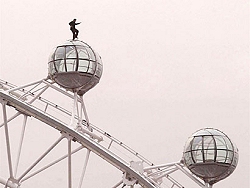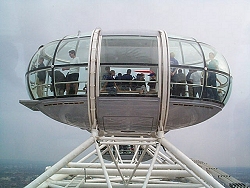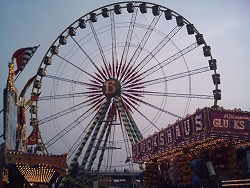|
.
As a
result, its place is now assured until at least 2027, and London mayor
Ken Livingstone recently moved to prevent the South Bank Centre from
endangering the Eye’s future by increasing the rent payable on the
Eye’s site, memorably describing the SBC chief Lord Hollick as “A
complete prat” in the process. At the height of this controversy, it
was threatened that the Eye may be sold and moved to Paris, where it was
hoped to land a decisive blow in the two cities’ battle to host the
2012 Olympics, a clear demonstration of how powerful an icon the Eye had
become.
As if to prove the its success
beyond all doubt, a recent industry survey listed the London Eye as the
best tourist attraction in the world, beating countless historic sites,
not to mention modern buildings and theme parks, to the title.
Similarly, its desirability as an icon has been proven by the fact that
so many cities have made requests to copy the idea, including Beijing,
Toronto, Johannesburg, and inevitably, Las Vegas.
Its status as a landmark,
however, does bring with it some rather unusual scenes. David Blaine
memorably stood on top of a pod at full height in a stunt reminiscent of
that which saw circus performer Madame
Solange d`Atalide complete a revolution of the Vienna
Reisenrad sitting
upon a horse on a cabin roof.
Similar, if less well -planned, scenes have come when protestors have
decided that bringing the Eye to a standstill would benefit their cause.
As a result, riders must go through security procedures that aren’t
too dissimilar to those before any other British Airways “flight”.
|

|
| The
London Eye has been in the news for numerous reasons. In this
instance, the reason is David Blaine. |
In many
ways, the story of the London Eye fits that of the original Ferris
Wheel. Both were initially dismissed as impossible, with many doubting
that they could be built, or that the public would be willing to pay for
such a ride.
Neither were given any funding, leaving it to the designers
to assemble a group of private investors to finance the project.
Both
had problems that led to them opening later than anticipated, a cable
snapping while attempting to lift the complete Eye structure from its
place flat-out over the Thames and onto the hub.
This caused
a great deal of embarrassment, as the failure took place in front of the
many TV cameras and reporters who had been invited to see the spectacle.
As a result, the Eye opened in March 2000, rather than January 1st as
planned (thus allowing an Eli type wheel, operating as part of a special
celebratory funfair in The Mall, to advertise itself as “The only
Ferris Wheel open in London”).
Perhaps the
great irony of the London Eye is its operators’ insistence that it be
referred to as “Observation Wheel” rather than “Ferris Wheel”,
in order to avoid the tacky fairground/theme park connotations that the
name “Ferris Wheel” is thought to carry, whereas a century earlier
Ferris himself rejected the name “Observation Wheel” because he
thought it too vulgar.
Indeed, the
FAQ page of the Eye’s website specifically answers “Is it a Ferris
Wheel?” in the negative, with the rather ludicrous and deluded
rationale that this is because the Eye features “Enclosed cabins”
and “A-frame design”, an argument that rather flounders when you
notice those very features on Ferris’s own design.
However the
owners wish us to describe it, it is difficult not to be impressed when
you stand before the London Eye. Not only does it look singularly
impressive, with its gleaming white structure, and web of support
“spokes”, and slender support structure; but its architectural
impact is quite stunning, being a symbol of how it is possible to
combine the modern and the traditional in such a way as to be beneficial
to both.
|

|
| The
'Eye is rare in that pods always remain on the outside of the
wheel regardless of position |
Today, the
Eye seems to have few critics, and has single-handedly allowed the
Ferris Wheel transcend the rest of the amusement industry and become one
of the world’s most impressive and recognisable forms of architecture.
From a rider’s perspective, probably the most impressive and
innovative feature is that the pods are fixed to the outside of the
wheel, giving a view from the top that is uncluttered by the wheel’s
structure.
With the
success of the London Eye, other cities were keen to replicate the idea.
At this point, Paris once again entered the fray, building the world’s
largest portable wheel, “Roue De Paris”, in the Place de la
Concorde. Originally intended to stay for the duration of 2000, it in
fact stayed until January 2002, when mayor Bertrand Delanoe instigated a
court action to have it removed, claiming that it had outstayed its
welcome and had become a blight on the historic square.
The
argument caused national debate, with the majority of people seemingly
in favour of keeping the wheel. Owner Marcel Campion was keen to keep it
in place, even offering to donate 20% of its profits to charity if it
were allowed to stay. This failed to sway the courts, who ordered it
come down. Rather amusingly, Campion suggested that the dismantling
could take several months, a spurious claim given that Roue De Paris was
identical to the “Bellevue” wheel that the Bruch family constantly
tours on the German fair circuit.
|

|
| Roue
De Paris was identical to Belle Vue, here pictured in Dusseldorf. |
Despite the
mayor offering to find the wheel another site in the city, Campion
eventually sold the wheel to World Tourist Attractions, a new company
founded by the British Shipley family (owners of a children’s theme
park in Stourport-on-Severn, and a nationwide chain of amusement
arcades), and fronted by Elliott Hall, the UK showman previously famed
for giving the country its first Mondial Top Scan, “Top Buzz”.
For
Christmas 2003, World Tourist Attractions brought the wheel across the
channel, and to Birmingham’s Centenary Square, where despite keeping
its “Roue De Paris” signage, it would be known simply as “The
Wheel of Birmingham”. The decision to build the wheel in the city was
received with surprisingly little controversy, partly because the
council had already announced tentative plans for a possible permanent
wheel on the other side of the city, and saw this is a way of testing
the idea’s popularity. Continues...
|